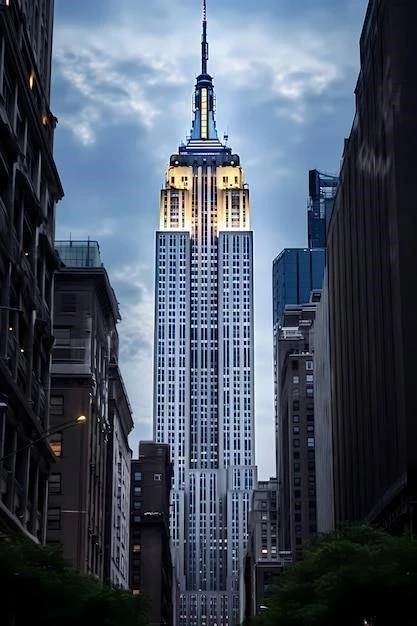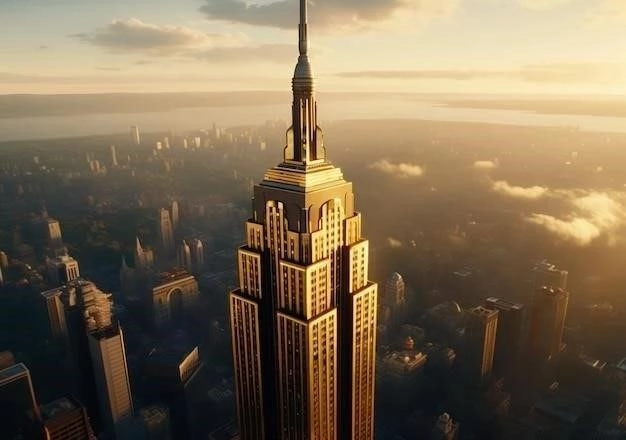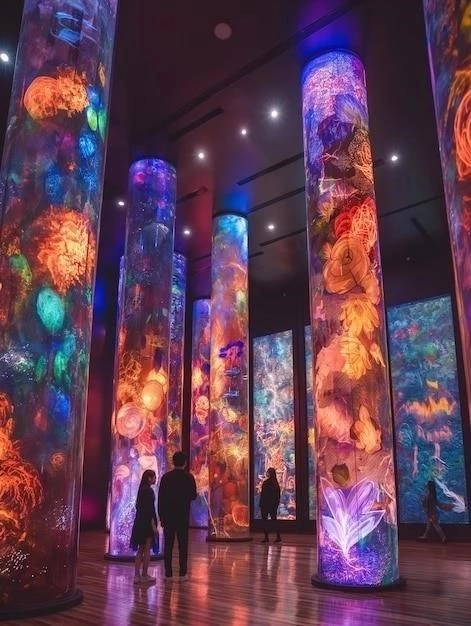History and Construction
The Empire State Building’s story begins in the fervent race to build the world’s tallest skyscraper during the late 1920s. The prestigious plot on Fifth Avenue, originally housing the Waldorf-Astoria Hotel, was acquired by Bethlehem Engineering Corporation, setting the stage for this ambitious endeavor. Construction commenced on March 17, 1930, under the supervision of architects Shreve, Lamb & Harmon. Employing an innovative assembly-line approach and the expertise of around 3,400 workers, the building rose at an unprecedented pace, averaging four and a half floors per week. Remarkably, the Empire State Building was completed in a mere 410 days, opening its doors on May 1, 1931, a testament to architectural ingenuity and human determination.
Architectural Design and Style
The Empire State Building stands as an enduring testament to the Art Deco style, which flourished in the 1920s and 1930s. This architectural movement, characterized by its sleek lines, geometric shapes, and lavish ornamentation, found its ultimate expression in this soaring skyscraper. The building’s facade, clad in Indiana limestone and granite, showcases a distinctive setback design mandated by the 1916 Zoning Resolution, which aimed to allow sunlight to reach the streets below. These setbacks, far from detracting from the building’s aesthetic appeal, contribute to its graceful, tiered silhouette, culminating in the iconic spire.
The Empire State Building’s interior likewise reflects the opulent elegance of Art Deco. The lobby, a soaring space that rises to the ceiling of the third floor, features rich materials such as marble, aluminum, and gold leaf. Intricate murals depicting various industries and technologies adorn the walls, celebrating the building’s role as a symbol of American progress and ingenuity. Throughout its history, the Empire State Building has undergone renovations to modernize its facilities while preserving its architectural integrity. However, its Art Deco core remains a testament to a bygone era of design and a defining element of its enduring appeal.
Height and Dimensions
The Empire State Building has long been a symbol of human ambition reaching for the sky. Its total height, including the pinnacle spire, is a staggering 1,454 feet (443.2 meters). For over four decades, from its completion in 1931 until 1972, it held the title of the world’s tallest building, a testament to the architectural daring of its era. Though it has since been surpassed in height by other towering structures, its iconic profile remains etched on the skyline as a reminder of its record-breaking past.
The building’s impressive verticality is comprised of 102 floors, with the highest visitable observation deck located on the 102nd floor. This observation point offers unparalleled panoramic views of New York City from an elevation of 1,250 feet (381 meters). The building’s footprint covers approximately 2 acres (8,094 square meters) at the street level. Its colossal size is supported by a robust steel frame weighing in at a hefty 54,400 tons. The sheer scale of the Empire State Building’s dimensions continues to inspire awe and wonder in those who visit and gaze upon its imposing presence in the heart of Manhattan.
Observation Decks: 86th & 102nd Floors
The Empire State Building offers an unparalleled perspective on New York City from its renowned observation decks on the 86th and 102nd floors. These lofty vantage points draw visitors from around the globe seeking breathtaking panoramic views. The 86th-floor observatory, soaring 1,050 feet (320 meters) above the bustling streets below, provides an open-air experience, allowing visitors to feel the city’s energy and marvel at its iconic landmarks. This observation deck has been featured in countless films and television shows, cementing its place in popular culture.
For an even more exclusive experience, visitors can ascend to the 102nd-floor observatory, situated at a dizzying height of 1,250 feet (381 meters). Enclosed in glass, this observation deck offers 360-degree views that extend for up to 80 miles on a clear day. From this vantage point, the cityscape unfolds in all its glory, showcasing the majestic bridges, verdant parks, and sprawling avenues that make New York City an architectural marvel. Whether choosing the open-air grandeur of the 86th floor or the intimate perspective of the 102nd floor, visitors to the Empire State Building’s observation decks are guaranteed an unforgettable experience.
The Empire State Building in Popular Culture
The Empire State Building has transcended its architectural significance to become a globally recognized cultural icon, its image deeply woven into the fabric of popular culture. Its instantly recognizable silhouette has graced countless films, television shows, books, and works of art, serving as a powerful symbol of New York City and, more broadly, American aspiration. From its memorable appearance in the 1933 classic “King Kong” to its starring role in romantic comedies like “Sleepless in Seattle” and “An Affair to Remember,” the building has provided a dramatic backdrop for countless stories.
Beyond its cinematic cameos, the Empire State Building has been immortalized in photography, painting, and literature. Its soaring height and Art Deco grandeur have inspired artists to capture its majesty from various perspectives, showcasing its evolving presence amidst the ever-changing cityscape. Its image has also been widely used in advertising and branding, becoming synonymous with strength, ambition, and urban sophistication. The Empire State Building’s enduring presence in popular culture is a testament to its enduring power as a symbol of human ingenuity, architectural grandeur, and the allure of the urban dream.
Visiting the Empire State Building
A visit to the Empire State Building is an essential experience for any visitor to New York City. To make the most of your trip to this iconic landmark, it is essential to plan ahead and familiarize yourself with the various options available. The building is open to the public daily from 8:00 am to 2:00 am, with extended holiday hours. Purchasing tickets in advance online is highly recommended, especially during peak seasons and weekends, to avoid lengthy queues at the ticket counters.
Upon entering the building, visitors are greeted by the opulent Art Deco lobby, recently restored to its original grandeur. A self-guided multimedia tour provides insights into the building’s history, construction, and cultural significance. High-speed elevators whisk visitors to the observation decks on the 86th and 102nd floors, offering breathtaking views of the city. Binoculars are available for rent on the observation decks, allowing for closer inspection of distant landmarks. Allow ample time to fully immerse yourself in the experience, taking in the panoramic views and capturing memorable photographs.
Tickets and Admission
The Empire State Building offers a range of ticket options to suit various preferences and budgets. General admission tickets grant access to the 86th-floor observatory, providing stunning open-air views of the cityscape. For those seeking an expedited experience, Express Pass tickets allow visitors to bypass the often-lengthy general admission lines, reducing wait times significantly.
Visitors wishing to elevate their experience can opt for the 86th & 102nd Floor Observatory tickets, which include access to both observation decks. This option allows for a comprehensive perspective of New York City, from the open-air grandeur of the 86th floor to the enclosed, panoramic views from the 102nd floor. It is important to note that ticket prices vary based on the chosen experience and time of day. Purchasing tickets in advance through the official website is highly recommended to secure the desired time slot and potentially benefit from online discounts.

Getting There: Location and Transportation
The Empire State Building is centrally located in Midtown Manhattan at 350 Fifth Avenue, between West 33rd and 34th Streets, making it easily accessible via various modes of transportation. For those utilizing New York City’s extensive subway system, the nearest station is 34th Street-Herald Square, serviced by the B, D, F, M, N, Q, R, and W lines. From this station, it’s a short walk eastbound along 34th Street to Fifth Avenue.
Numerous bus lines also operate along Fifth Avenue and nearby streets, providing convenient access to the Empire State Building. If traveling by taxi or rideshare services, simply provide the address: 350 Fifth Avenue. For those who prefer to drive, parking garages are available in the vicinity, though rates can be expensive. Given the convenience and accessibility of public transportation in New York City, opting for the subway or bus is generally the most efficient and cost-effective way to reach this iconic landmark.

Fun Facts and Trivia
Beyond its architectural grandeur, the Empire State Building boasts a fascinating history filled with intriguing anecdotes and lesser-known facts. During its construction, the building rose at an astonishing pace, averaging four and a half floors completed per week. The entire construction process took just 410 days, a testament to the efficiency and innovation of the era’s building techniques.
Contrary to popular belief, the Empire State Building’s spire was not originally intended as a decorative element but as a mooring mast for dirigibles. However, this ambitious plan proved impractical due to strong winds and air currents at such heights. Today, the spire serves as a broadcast antenna for numerous television and radio stations, transmitting signals across the tri-state area. The Empire State Building’s enduring appeal lies not only in its architectural splendor but also in the captivating stories and trivia that have accumulated over its long and storied history.

The Empire State Building’s Impact on New York City
The Empire State Building’s impact on New York City extends far beyond its imposing physical presence. Since its completion in 1931, it has served as a symbol of the city’s ambition, resilience, and architectural ingenuity. During the Great Depression, its construction provided much-needed employment opportunities, offering a beacon of hope during challenging economic times.
The building’s status as a global tourist destination has contributed significantly to New York City’s economy, attracting millions of visitors each year who contribute to the city’s tourism industry. Moreover, the Empire State Building has played a pivotal role in shaping the city’s skyline, inspiring subsequent generations of architects and developers to reach for new heights. Its enduring legacy continues to define the spirit of New York City, representing the boundless possibilities that arise from human ambition and innovation.
Sustainability Efforts
The Empire State Building stands not only as an icon of architectural ingenuity but also as a leader in environmental sustainability. Recognizing the importance of reducing its ecological footprint, the building’s management has implemented a comprehensive sustainability program encompassing energy efficiency, waste reduction, and water conservation measures.
Through a series of innovative retrofits, including the installation of high-performance windows, insulation, and lighting systems, the Empire State Building has significantly reduced its energy consumption. The building has also implemented a robust recycling program and partnered with local organizations to divert waste from landfills. Furthermore, water-efficient fixtures and appliances have been installed throughout the building to minimize water usage. The Empire State Building’s commitment to sustainability sets a high standard for other skyscrapers worldwide, demonstrating that even historic buildings can embrace environmentally responsible practices without compromising their iconic status.

The Future of the Empire State Building
As the Empire State Building enters its second century, its future remains inextricably linked to the ever-evolving landscape of New York City. While its iconic silhouette remains a timeless fixture on the skyline, the building continues to adapt to the changing needs of its tenants and the expectations of its visitors. Ongoing renovations and technological upgrades aim to enhance the visitor experience, ensuring that the Empire State Building remains a top destination for generations to come.
The building’s management is committed to preserving its legacy while embracing innovation, seeking new ways to engage visitors and enhance its sustainability efforts. From interactive exhibits and immersive experiences to expanded dining and retail options, the Empire State Building is poised to remain a vibrant hub of activity and a symbol of New York City’s enduring spirit. As the city continues to evolve, the Empire State Building will undoubtedly adapt and thrive, solidifying its status as a timeless landmark and a testament to human ingenuity.










